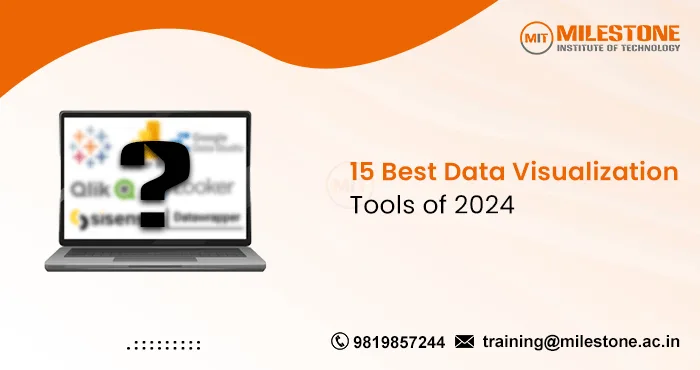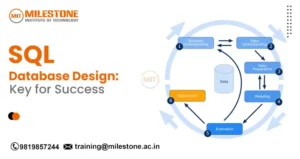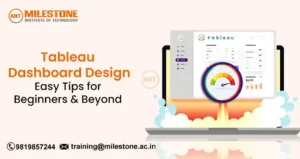In this ever-evolving data-driven field of data analysis, effective data visualization is important for transformation of raw data into more clear and meaningful insights. Choosing the right data visualization tool could help business users, data scientists, and analysts for presenting data in an easy to understand format which enables informed decision-making. In this complete guide we have mentioned all the 15
best data visualization tools with their crucial features and applications.
Best Data Visualization Tools
There are many data visualization tools which are used for powerful understanding and communicating complex data. If you are a beginner or an experienced data scientist, business professional, or analyst, proper data visualization is important which will help in making informed decisions.
1. Tableau
Tableau is the most widely used tool for data visualization which will be owned by Salesforce in 2019. It has the ability of handling huge datasets and complex data visualization which makes it a most favorite tool among data scientists and business analysts. There are many sectors where tableau is used mostly which includes finance, business, retails, healthcare, and many to gain quality insights from the raw data.
Features:
- Drag-and-drop interface
- Real-time data analytics
- Integration with numerous data sources
- Advanced mapping capabilities
- Extensive library of charts and graphs
2. Microsoft Power BI
When it comes to data visualization, another well-known and often used tool is
Power BI, a Microsoft product that was released on July 11, 2011. It is used in many business operations to create comprehensive dashboards and reports which include clear and structured insights. Power BI is popular in different sectors which includes marketing, sales, finance, and IT because of its powerful abilities.
Features:
- Seamless integration with Microsoft products
- Real-time dashboard updates
- Natural language Q&A
- AI-powered data modeling
- Extensive custom visualization options
3. Google Data Studio
Google Data Studio is a best choice for medium as well as small sized businesses which are looking to leverage their Google data. Its primary applications are in online analytics, performance reporting, and digital marketing. The collaboration feature makes it a more beneficial tool for teams to work together on big projects.
Features:
- Integration with Google AdWords and Analytics, among other services
- Real-time collaboration
- Customizable reports and dashboards
- Easy sharing and embedding options
- Free to use
4. Qlik Sense
Qlik Sense is widely known for its solid features related to data discovery and self-service. It is majorly used in the industries such as manufacturing, financial, and healthcare services for evaluation of large data and to uncover the hidden insights from the data. Its interface is more mobile friendly which makes it a great choice for field workers who need access to data on the go.
Features:
- Associative data model
- AI-driven insights
- Interactive dashboards
- Self-service data preparation
- Mobile-friendly design
5. Domo
For businesses who need to combine data from several sources and display or visualize it instantly, Domo is quite beneficial. In finance, retail, and logistics, we most frequently monitor key performance indicators (KPIs) and make quality data-driven decisions.
Features:
- Cloud-based platform
- Real-time data integration
- Extensive library of connectors
- Customizable dashboards
- Advanced analytics and machine learning
6. Looker
Looker is the go-to option for businesses using Google Cloud services. People widely use it for creating custom data applications and embedded analytics solutions. Looker is popular in tech companies, e-commerce, and SaaS businesses for its flexibility and powerful data modeling features.
Features:
- Browser-based interface
- Integration with Google Cloud
- Advanced data modeling
- Customizable and interactive dashboards
- Embedded analytics capabilities
7. Sisense
Sisense is known for its robust performance with large datasets, making it ideal for industries such as manufacturing, healthcare, and telecommunications. It’s used to create highly interactive dashboards and to perform complex data analysis tasks, providing valuable insights into business operations.
Features:
- In-chip analytics
- Integration with various data sources
- AI-powered analytics
- Customizable dashboards
- Scalability for large datasets
8. Chartio
Chartio is favored by businesses that need a simple yet powerful tool to visualize their data. It’s often used by startups and small businesses for performance monitoring, sales analytics, and marketing campaign tracking due to its easy setup and straightforward interface.
Features:
- User-friendly interface
- SQL-based data querying
- Real-time data updates
- Customizable dashboards
- Integration with cloud services
9. Zoho Analytics
Businesses already utilizing the Zoho product suite would do well to consider Zoho Analytics. The departments of sales, marketing, finance, and HR use reports and dashboards to make strategic decisions, created in detail.
Features:
- Drag-and-drop interface
- AI-powered data analysis
- Integration with Zoho suite and other applications
- Pre-built analytical functions
- Interactive dashboards
10. Klipfolio
Klipfolio is popular among marketing agencies, finance teams, and operations managers who need to monitor real-time data. Its ability to pull data from various sources and present it in a cohesive manner makes it a valuable tool for tracking KPIs and performance metrics.
Features:
- Cloud-based platform
- Real-time data dashboards
- Extensive library of integrations
- Customizable data visualizations
- Pre-built templates
11. Datawrapper
Datawrapper is a favorite among journalists and media companies for creating visually appealing charts and maps. It’s used to present data-driven stories and reports in an engaging format, making complex data easily understandable for readers.
Features:
- Simple and intuitive interface
- Customizable charts and maps
- Easy embedding options
- Export to multiple formats
- Free and paid plans available
12. Infogram
Infogram is widely used in marketing and education to create interactive infographics and presentations. Its huge template collection and user-friendly interface make it simple to swiftly design images of professional quality.
Features:
- Drag-and-drop editor
- Customizable templates
- Interactive charts and infographics
- Integration with cloud storage services
- Real-time collaboration
13. Highcharts
When developers need to include interactive charts into online applications, they usually use Highcharts. It’s commonly used in financial services, media, and tech industries to create detailed and interactive data visualizations.
Features:
- Wide range of chart types
- Interactive and responsive charts
- Extensive API for customization
- Integration with various platforms
- Detailed documentation and support
14. Plotly
Plotly is popular among data scientists and researchers for its ability to create highly interactive and detailed visualizations. It’s used in academia, finance, and engineering to analyze complex datasets and share insights.
Features:
- Open-source and commercial versions
- Support for various programming languages
- Interactive and publication-quality charts
- Integration with analytics and BI platforms
- Real-time streaming data
15. Flourish
Flourish is widely used by media organizations, educators, and marketers to create engaging and interactive visualizations without the need for coding. Its rich template library and ease of use make it a valuable tool for telling data-driven stories.
Features:
- No-code visualization tool
- Wide range of templates
- Interactive and animated visualizations
- Easy embedding and sharing
- Free and paid plans available
Which is the best institute to learn Data Analytics and Data Science ?
You may be wondering how to get started in a profession of
data science and data analytics, or where to learn these skills. As per the review and rating we have observe Milestone Institute of Technology is the best institute which provides IT Courses as well as Engineering Software Courses. Their faculty focuses on providing best for there students with practical training, personal guidance and many more for students success. Start your journey from today and achieve your successful career goals.
Frequently Asked Questions (FAQs)
What is the importance of data visualization?
Data visualization is crucial because it transforms complex data sets into visual formats that are easier to understand, interpret, and act upon. Better decision-making is facilitated by its assistance in spotting patterns, trends, and outliers in data.
How do I choose the best data visualization tools for my need?
Choosing the right data visualization tools depends on several factors, including the complexity of your data, your specific use cases, the level of interactivity required, integration needs with other tools, and your budget. Evaluating these factors will help you determine the most suitable tool.
Are there any free data visualization tools available?
Yes, there are several free data visualization tools available, such as Google Data Studio, Data wrapper, and the free versions of Tableau Public and Microsoft Power BI. These tools offer robust features that can meet the needs of small to medium-sized businesses and individual users.
Can data visualization tools handle real-time data?
Many modern data visualization tools, such as Tableau, Microsoft Power BI, and Domo, offer real-time data integration and dashboard updates. This capability is essential for businesses that need to make timely decisions based on current data.
Can I integrate data visualization tools with other software applications?
Yes, most data visualization tools offer extensive integration capabilities with various software applications, including CRM systems, marketing platforms, cloud storage services, and more. This integration ensures seamless data flow and a unified view of business metrics.




